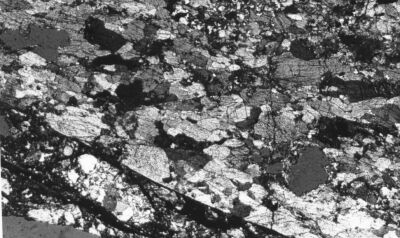
5. CENTRAL AMPHIBOLITES
Distribution and. Lithology; 'The Central amphibolites' are exposed, in veins cross-cutting the foliations of rocks of the igneous complex. They are particularly well exposed, on the coast to the south of Uamh and in the area to the east north east of Ard Mor. They generally occur in groups, with widths between a few inches and three feet. They do not extend, far along their dominantly ENE-WSW trend. Occasionally they may contain garnet and feldspar in addition to hornblende. A vein of hornblende exposed near the southernmost point of Ard Mor (figure 5 - not available) was measured as being 20 feet long with
a trend of 109
Another vein, exposed on the northern side of Eilean Collam has a mineral comnosition of 80% hornblende, 18% plagioclase and 2% magnetite-ilmenite. The contact of this rock type with the surrounding impure anorthosite (plate 3) shows no signs of chilling but is sharp. The plagioclase is an andesine and shows little sign of alteration. The rock is relatively fine-grained (average grain size 0.8mm). It is probable that the boudins of amphibolite observed in the migmatites (section 6) also represent a dyke of this rock type.

Plate 3: Contact of amphibolite with anorthosite, from a sample collected near Eilean Collam.
Origin and Age; The cross-cutting relationship of these amphibolites to the rocks of the igneous complex distinguishes them from the amphibolites of the igneous complex itaelf. However this is the only evidence for such a distinction, as rook types are very similar. They undoubtedly post-date the layering of the igneous complex rocks but may represent later igneous activity related to the igneous complex. Such activity was probably the intrusion of basaltic or doleritic dyke swarms. These dykes have been metamorphosed in the amphibolite facies, with the result that olivine has been metamorphosed to garnet, and pyroxenes to hornblende. There is no evidence in these rocks for earlier metamorphic assemblages (such as garnet-pyroxene ones), as there is in some of the other amphibolites of the igneous complex exposure.